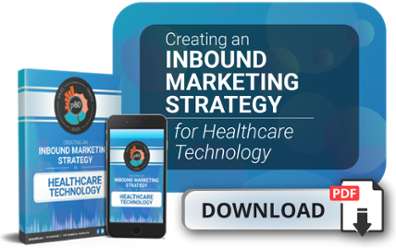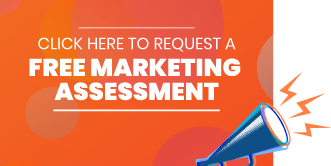WEBSITE COPYWRITING
For Saas and Medical Tech Marketing
So you’re starting to write for your healthcare tech content marketing team. Or perhaps you’re in charge of one, and want to make sure they’re executing the right way. Or maybe you’re even considering outsourcing to SaaS content writing services and want to know what that process looks like.
Either way … congratulations on your business-altering decision!
B2B companies can change their fortunes forever by embracing the modern buyer’s demand for educational content, whether you’re a:
- Healthcare technology marketing writer
- SaaS content writer
- Medical technology marketing writer
Today’s buyers won’t let you get away with sporadic or poorly written content. Did you know the average B2B buyer reads 13 pieces of content before making a purchase choice? If you don’t put together a medical software or device marketing strategy that connects with those readers, someone else will.
This mega-resource is, pun intended, the last word on B2B SaaS, medical technology, and medical device content writing. Along the way, we’ll show you real-life examples that we’ve seen actually work.
Click the anchor links below to zoom to a specific branch of marketing:
B2B vs. B2C Content Writing
B2B content writing is directed at a person who makes decisions for a company. B2C hits a broader range of potential customers -- they’re the ones selling you Skittles, car insurance, and salon products.
Education and playing “the long game” is extra-important in healthcare and B2B SaaS content marketing. You play the role of a consumer in your everyday life -- think about how overly aggressive, sales-y emails and social media posts make you feel.
Even B2B healthcare marketing has its own sub-genres. The decision maker at a nursing home may have different needs and tastes than a CEO at an urban hospital. Medical device content marketing may not look the same as healthcare SaaS marketing.
If your content marketing strategies are painting with broad brushes, stop and reassess your work.
 |
Traditional
|
Healthcare Tech Content Marketing |
|
Sales Cycle |
Short |
Weeks to years |
|
Buyer Persona |
Can be vague, depending on product |
Hyper-focused |
|
Writing Style |
Sales-focused (with some inbound marketing) |
Education-focused |
|
The Star of the Show |
The product |
The buyer! |
You’ll get nowhere without writing to your audience in the style and delivery method your healthcare or Saas persona prefers.
Basic Blog/Website Copywriting Tips
Not everyone has an entire content marketing team to leverage. There’s been great debate about the ROI of in-house content marketing vs. outsourcing to a B2B content marketing agency.
Let’s put those concerns and arguments aside and show you how it should be done regardless of team size and location. Since we can safely assume most small- and mid-sized medical tech companies don’t employ dedicated writing experts, we’re starting at square one -- the basics of great marketing copy.
How to Write Clearly, Concisely, and With Strength
It’s one thing to know how to publish a social media post or format a blog post. Almost anyone on your team can do that (except maybe your 35-year veteran in Accounting who still "bookmarks" webpages by handwriting them).
That said, it requires a whole new level of understanding to successfully write clearly, concisely, and with strength. You have literally seconds to make an impact on your reader -- here’s how to make them count.
Website & Blog Copywriting -- Clarity
Not every reader is going to read every single word of a business blog, product page, or email -- again, this is especially true for B2B content marketing. They may skip words, sentences, or even entire sections.
Always assume that your reader knows very little about the topic or your industry. Avoid complicated jargon and “shop talk” that’ll confuse your reader.
Other SaaS/medical device marketing best practices for writing:
- Know your audience -- Salt-of-the-earth, or white-collar? Over 80% senior citizens? Your buyer persona (more below) should inform your writing style, or what terms and tech those in your audience’s industry will understand.
- Set expectations with your headline -- Your headline should provide the reader with clear expectations for what will be in the article.
- Put the ball on the tee -- Your introduction should clearly convey what’s coming up in the article and why it’s important to the reader. Then use the body of the content to drive the point home.
- Use easy words -- Unless your persona indicates otherwise, keep your language simple and easy to understand. This resource suggests writing at an 8th-grade level.
- Don’t serve the appetizer last -- Organize your information by importance and in the order you want readers to consume it. The clock starts ticking as soon as your prospects opens a blog post -- how will you convince them to keep that tab open?
- Be consistent -- Pick a single point of view, and maintain it throughout the article. You don’t want a reader getting stuck for 5 minutes trying to figure out who’s who.
- Avoid typos and other nonsense -- Use a program like Grammarly if you’re not confident in your grammar and syntax abilities. (Or hire a website copywriting services team.)
Blog & Website Copywriting -- Conciseness
Conciseness (or, concision, if you’re feeling fancy) means you’re not bogging down your reader with excess wording and irrelevant information. As more buyers browse websites via mobile devices, they’re less inclined than ever to stick around -- unless you get to the point.
- Use bulleted lists and bolded snippets -- These make your content more digestible and scannable, and help important points stand out.
- Loosen up -- Don’t be stiff. Don’t be afraid to use contractions. Talk to your reader like you’d talk to Mom.
- Tighten up -- Keep your paragraphs short so they don’t look like a chore to read. An 11-sentence block of text is daunting and just plain ugly.
- Cut the fat -- Avoid using excess words. As much as possible, keep your sentences under 25 words -- or 20 if you really want a challenge.
Examples of Concise Marketing Copywriting
Keep an eye out for “fluff” and word strings that don’t add anything to the sentence. Your goal is get that reader to take further action on your website -- make your copy the avenue, not the roadblock.
- BAD: “In our opinion, we think metal manufacturing goes a whole lot better when the vendor is informed by you about any potential defect risks ASAP.”
- GOOD: “Metal manufacturing goes more smoothly when you inform the vendor about any defect risks ASAP.”
By removing phrases like “we think” and “by you,” you convey the same information quicker and with more confidence and style.
How to Write With Strength
Not every blog topic is going to be a thriller -- sometimes you need to convey the dirty, technical details. So how do we move the reader from point A to point B?
First, hang your hat on strong verbs. Powerful verbs eliminate wordiness and help you avoid passive voice. Most of all, they demand attention.
Examples:
- “Lunch was superb” > “Lunch was really quite good.”
- “We discovered a new technique” > “We got a new process we found.”
- “Her tangled rings of hair bounced like a rabbit” > “Her hair was a mess.”
Avoid passive voice. Always emphasize the subject of the sentence. Failure to do so makes you sound less authoritative or confident.

Not familiar with the war between active vs. passive voice? Allow us to introduce the “zombie” method of checking your copy for passive voice.
Try it: Add the phrase “by zombies” to the end of your sentence. If the sentence still makes sense after adding it, you probably used passive voice.
Examples:
- “Lean manufacturing can be learned (by zombies).”
- “(By zombies) can learn lean manufacturing.”
The second sentence is the stronger one because the subject (zombies) was the emphasis and no longer made sense after adding “by zombies” to the end.
How to Use Storytelling in Marketing for Medical Device & SaaS Personas
We’ve established that the customer -- not your company -- should be the hero in your story. But how do you write the story around that hero?
Here are five med tech/SaaS website ideas that focus on telling an epic story -- your customer’s.
1. Get to know Chester.
Marketers who target specific personas from the get-go have a huge lead in the race to attract customers during long B2B sales cycles.
You do have a buyer persona, right? If not, make one immediately. Give him or her a name. Like Chester. This fictitious character represents your ideal customer -- the one you’d love to clone 100x. You absolutely can’t skip this step, no matter how busy you are.
Does your company sell to multiple personas? For example, a manufacturer of metal components might sell both to OEM engineers and to architects -- two very different types of people. If you have multiple business verticals, keep ’em separated.
Ask your sales team what questions or issues they’re hearing most often from their Chesters. Interview current customers to get their side of the story -- your idea of what matters most to your customers may differ from what they feel is most important. They may even refer to the type of product/service you sell by a different name than you do!
Finding Chester’s pain points and empathizing with him is a great way to build trust.
2. Break the fourth wall.
Feel free to break all the rules of your old composition classes and write in the second person. Using “you” makes it feel like you’re speaking directly to the reader.
You can also refer to their industry and lifestyle -- all information you hopefully obtained during buyer interviews and persona constructing.
Ex.: “Poorly communicated design specifications can be a time-waster for engineers and purchasing agents who’d rather spend their weekends in the stands at their kids’ baseball games.”
3. Know their motivation.
What’s your ideal customer’s story? Her motivation? Here are some examples of emotions you can ignite in readers:
- Fear
- Excitement
- Curiosity/eagerness to innovate
Let’s use a fear example. A medical cleaning device supplier might want to show the fatal effects of dirty hospital rooms. Very effective in today’s world -- just don’t be dishonest or overpromise.
4. Meet them where they are.
To get an idea of how your prospects think and talk, meet them where they are.
Poke around whatever social media channels or industry forums your buyer persona research points you toward. Again, you should know which sites to investigate because you built a persona and interviewed your best customers … right?
Next, think about the delivery method. Is your persona frequently on the go and doesn’t have time for 3,000-word, highly technical blog posts every week? Is the subject matter best explained with supplementary visuals (i.e. photos, videos, and infographics)? Think about how to speak to them in the manner they prefer.
It’s not just a matter of the literal where and how. You also need to consider where the person is at in the buyer’s journey. Shilling your brand can be a big roadblock to generating leads if your audience is nowhere close to being ready to buy. On the flipside, spamming your closed customers with Awareness-stage emails isn’t productive, either.
 5. Make the language match the audience’s
5. Make the language match the audience’s
Do these people “get” your industry, or do they need hand-holding re: your product or service? Don’t talk over the heads of your readers with confusing industry jargon.
Writing to owners of tow truck fleets? They probably won’t get or appreciate fancy, fluffy, or sappy language. This can be the difference between engaging an audience or losing it within seconds.
(Example: The webpage you’re reading right now doesn’t use obscure marketing terms like BoFU content, long-tail keyword, or click-through rate because we don’t want to scare you away.)
However, audiences of, say, CEOs who love traveling to see other cultures may appreciate your fancy prose.
When your buyers talk to you, are they professional, casual, a little humorous, or a little technical? This should be the basis for your own word usage.
Here’s an exercise: Jot down words that best describe your product or service, and keep them in mind when writing. For example, for a hospitality designer persona you might scribble down:
- Uniqueness
- Trend-setting
- Customization
- Potential
- Futuristic
- Historic
- Execution
- Emerging
- Remarkable
- Enduring
- Refined
Business Blog Articles vs. Standard Website Copywriting
If you don’t have much experience creating med tech or SaaS website content, then you probably don’t fully understand the difference between writing a blog post and writing for other parts of your website. The length, tone, and approach of your core website pages should be different from that of your blog posts.
When it comes to the rest of your website, the primary focus is on sales. You’ll provide specific information about your product or service and how it solves your customer’s pain points. Standard website copywriting tends to be shorter and more direct than most B2B marketing blogging.
Blog posts should be more educational and informative. They don’t try to push a specific
product as their main focus -- at least not in an overt, beat-you-over-the-head way. The goal of a SaaS, healthcare, or other B2B marketing blog is to add credibility to your brand and help you connect with your ideal audience.
So, what does this look like in practice?
Website Copywriting
Remember your primary goal is to get people to fill out a form or take some other next step on your website. Don’t distract with a bunch of fluff or unnecessary external links, and never create a dead-end situation for the audience. You should always be shepherding them toward the next step.
5 Homepage Copywriting Tips
For most visitors, the homepage is the first thing they see on your site.
When writing copy for websites, think of the homepage as the shop window. In the early days of digital healthcare marketing, websites were basically e-brochures. Nowadays, your buyers expect a website that’s both functional and informative.
With a homepage, time and space for copy are limited. Videos, images, and other visual elements often take precedence. While snazzy graphics are great, they have limited SEO impact.
Until further notice, you still need great copy too. Here’s how to meet those expectations:
1. Offer a Relaxing SPA
The SPA method of copywriting flips the script of traditional copywriting best practices.
- Your company’s SOLUTION should be the first copy a reader sees on your homepage. Leading with your solution -- but writing it in a customer-centric way -- lets your visitor know precisely what they can expect from your product/service.
- Reinforcing the PROBLEM next allows for a sense of personalization and belonging. It shows that you understand the reader’s pain point, and therefore understand how to solve it.
- The final step, AGITATION (or perhaps ALLEVIATION), comes at the point where your visitor is really looking for proof that your solution matches their needs. Reiterate your solution and share social and data-driven proof.
2. Serve Their Coffee With Skim
What catches your eye more in a print ad -- the big-but-simple “70% CLEARANCE SALE” graphic, or the 200-word fine print section?
It’s the former.
Yes, some of us are allergic to milk, but skimming is how nearly all of us consume content at least some of the time. As such, you should always write copy with skim readers in mind.
Those first 5-25 words are a huge factor in how long visitors stay on your site and whether they visit additional pages -- or leave for a competitor’s site. Use those first 5-25 words to assure visitors they’ve arrived at the right place, and how their lives are about to get better by using your solution.
Here are some great examples we’ve seen recently: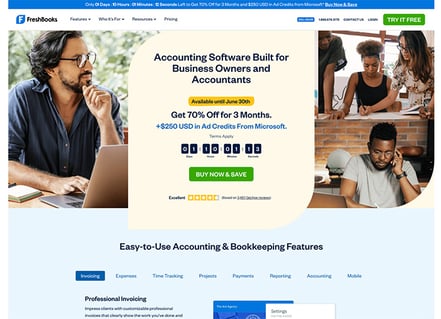
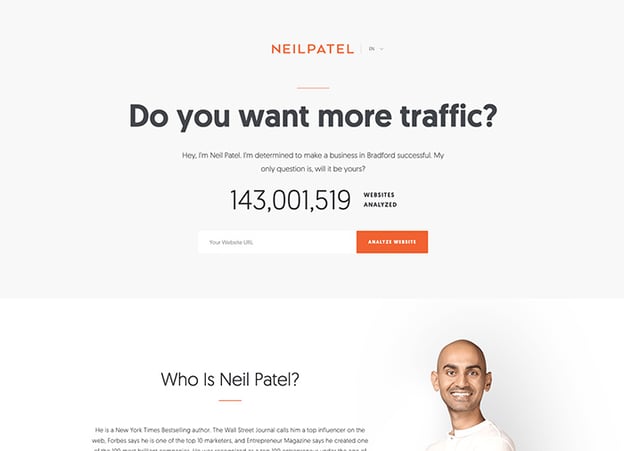
None of these examples is exceptionally clever. But they use simple, clear language to leave 0% doubt about what the company does and how the customer benefits.
In summary, embrace your skimmers -- don’t shun them! Break up your paragraphs so they look less daunting. Front-load sentences with the most important or catchy bits.
3. Enough With the Academic/PR Talk
You’re not just a “quality solutions provider.”
You don’t “level up alignment.”
You’re not “pioneering the digital transformation.”
You don’t represent “the paradigm shift for integrated software.”
And, finally, you’re not a “scalable growth hacker disrupting the status quo of global experiences.”
Respectfully … please stop.
Pretentious, overblown writing not only makes you sound insincere, it also makes it hard for readers to tell what you actually … do. Not to mention search engines.
When writing a homepage, write in the same language your audience uses, sprinkling in important keywords.
Be like this company instead. One hundred percent clarity on what it offers, and there’s even a free offer right up front!
4. Prove It
Again, calling your medical device “high-quality” or your after-sales support “excellent customer service” doesn’t tell the reader anything. Every single one of your competitors is making the exact same claims.
Great marketing copywriting doesn’t tell; it shows.
If you have proof your company’s the best, write about its awards and post testimonials. If your on-time delivery rate is #1 in your industry, give a concrete timeline for your product’s arrival and back it with a guarantee. If you have regulatory certifications that are crucial to your customer’s compliance needs, highlight them.
5. Ask Them to Stay for Dinner
Your readers have sipped their cup of coffee with skim, and might be tempted to leave your site. Before this happens, encourage them to visit other relevant pages.
Do you have blog posts, e-books, or case studies? Briefly mention them and provide links. Giving away free education builds trust and proves your expertise.
6 Landing Page Writing Tips for the Time-Crunched
What’s a landing page, you ask?
Unlike typical webpages, which have multiple goals and encourage exploration, landing pages promote a single focus or goal. A landing page is a standalone page created specifically for a marketing or advertising campaign. Prospects often find these pages by clicking a call-to-action, or CTA, elsewhere on your site (see the 99 Healthcare Management button above for an example).
The best practices of writing copy for landing pages are similar to those of other pages, but be extra-careful to follow these six rules:
1. Use customer testimonials.
One of the most powerful conversion copy techniques is to have someone else do it for you.
Customer testimonials produce conversions for one simple reason -- they’re living, breathing proof that your solution works.
(p80 tip: Bonus points your testimonials are available in video form too. This may still require you to write copy so the customer has a “script.” Also, any video should be accompanied by on-page copy so the page is rankable in Google.)
2. Bring the benefits, not the brand.
It hurts our egos as CEOs or marketers, but it’s true. Most customers don’t care about your company (unless you’ve perfected years of post-sale customer delighting).
A Harvard study of 1,400 B2B customers in a variety of fields concluded that traditional “solution-selling” tactics are practically dead. By “solution selling,” we mean the method where salespeople align a solution with a customer need, and then explain why the seller’s solution beats the competition’s.
This study happened back in 2012. And we’re still catching up to the truth.
Solution-selling approaches don’t account for one basic truth of modern buying: Customers usually already know what they’re looking for. They can self-troubleshoot virtually any pain point thanks to the internet and search engines.
By pitching only your solution, you’re not giving your customers what they need and want to make a buying selection. Yes, you should mention your solution enough to signal to the customer that they’re on the right website, but from there it’s all about the benefits, baby.
3. Think long and hard about your headline.
We warned you already: Readers skim -- or, worst-case, only read the headline.
This can be depressing to someone who spends hours crafting the perfect landing page copy. But rather than cry over spilled skim milk, spend some of that time making a better headline.
To learn how to make a clear and compelling headline, “visit our “how to write a headline” section below.
4. Stick to simple ingredients.
Would you serve roast lamb with mint sauce and sautéed mushrooms for an 8-year-old’s birthday party? Nope.
Marketing copywriting isn’t always about showing what a great “cook” you are. Simplicity sells, as you see here:

(Edupath)
Nobody agonized for days on end to come up with the perfect words for these examples. These companies simply spoke like humans, to humans, and did so as clearly and directly as possible.
5. Get specific and mathy.
The more specific you are, and the more numbers and data you can show, the more believable you’ll be.
- BAD: “Your medical billing services will be more efficient and cost you less money. Best of all, we’ll update your software.”
- GOOD: Reduce your billing data entry time by 85% and reduce the revenue loss associated with paper billing by 25%. We’ll even give you free yearly updates to keep you efficient.”
Anyone can make vague claims of quality. Your landing page web copy should cite stats and detailed metrics to prove yourself.
6. Offer dessert one more time (your CTA).
You should have started writing your landing page with your end goal already in mind. This “goal” is typically the submission form you want your prospect to fill out to receive that e-book, whitepaper, or consultation you’re offering. The true goal, of course, is to get this in exchange for the visitor’s email so they become a lead.
To further stress the importance of downloading the offer, make a final tease. Here are two effective examples:
- “Fill out this brief form to get your free e-brochure. If there’s a charge-capture problem at your hospital, this handbook is a great starting tool for learning how billing software can help:”
- “Vendor-contractor dialogue should happen ASAP in the medical device design phase. To start collaborating on a better design today, contact an engineer via this form:”
Even the words on your “submit” button matter! A simple “Submit” won’t cut it. Something more specific, like “Get the Checklist” or “Book a Consultation” is more attention-grabbing and action-oriented.
Marketing Blog Tips
Most of the basic laws of general website copywriting still apply to your blog. Make the customer the focus, write to the correct audience, and provide value (not sales pitches).
We’ve already touched on what makes SaaS and healthcare tech blog writing unique. Now let’s discuss how to get started -- and what needs to happen before you even start a Word or Google document.
Research
Let’s be honest: Research kind of sucks. This is especially true if you’re writing about a dense or highly technical subject. One of the few advantages of handling your content marketing in-house vs. outsourcing to an agency is that you have experts right down the hall.
Those experts -- and Google -- are imperative for gathering facts, numbers, and links that’ll back up your stance.
Accurate and up-to-date information is a must for healthcare marketing. This sounds hyper-obvious, but it bears repeating -- as soon as you publish a false claim or inaccurate information, you’re at risk. Giving false information to prospects could result in loss of trust and maybe even litigation.
When all else fails (i.e. your in-house experts aren’t giving you the time of day), Google is your friend. Paraphrase reputable sources, and credit them with a link back to their information.
Here are some great places to gather info for your next article:
1. Industry News Sites (Your Industry AND Your Clients')
The easiest avenue to information is Google-searching your topic and checking out the first page of results. This method is especially useful if you’re writing about current trends or news.
Sign up for industry newsletters to make this step even easier.
2. Social Media & Forums
Are your customers, competitors, or industry’s thought leaders busy on social media? Follow their accounts or check relevant hashtags to find posts relevant to your topic.
You can also Google search for Reddit threads or other forums dedicated to your topic’s industry to learn what people are talking about:
- Are they losing time or money over a job-related inefficiency?
- What do they love about a certain product?
- What concerns do they have over a potential solution?
3. In Your Backyard (Metaphorically)
Don’t be bashful about badgering your client or boss for details. If your article is factually flawed, it’s not going to convert and leads won’t share it, and your boss will be mad anyway.
Before your content marketing campaign starts, communicate that you need access to the company’s in-house experts. Establish a relationship with at least one person who understands the nitty-gritty details of anesthesia billing, pacemakers, or whatever you’re writing about.
4. Stalk Your Client’s Competitors
From NFL teams to fast-food companies, everyone “borrows” successful trends. It’s time you got in on that (legally).
Round up a list of competitors. See if they’re blogging or posting on social media. Subscribe to their newsletters.
 5 Tips for Discovering the Perfect Headline
5 Tips for Discovering the Perfect Headline
Depending on your topic and the availability of resources, the actual writing of your blog post might be the easy part.
Kicking it off with a great blog post title is arguably the biggest deciding factor of whether or not someone finds and reads your article.
- 80% of people read headlines, but only 20% go on to read the article.
- 59% of people will share an article without reading it first … or ever.
Here’s how to write a blog post title that acts as a lead magnet:
1. Research Keywords
Sorry. We tricked you. Your research isn’t quite done yet.
Similar to any other marketing copywriting, your title should account for searcher intent. Include at least one keyword in your title -- one your ideal customer would use when researching the topic. If you don’t have an SEO expert on-staff, you’d better find one fast, or outsource to an inbound marketing agency. If you don’t find keywords, leads won’t find you.
We’ll cover SEO and keywords in greater detail in a bit.
2. Engage the Reader
A good blog post title should be intriguing or actionable (or both), and jolt the reader with a sense that they have something to gain (or lose) by continuing.
Use terms like “How to” or “You” to speak directly to the reader. Power words are also great for making blog post titles sound actionable and intriguing. For example:
- JUST OK: “Smart Medical Device Design Shortcuts to Increase Efficiency”
This blog post title is boring and doesn’t invoke much emotional response from readers.
- MUCH BETTER: “5 Genius Medical Device Design Tips for a Happy Boss & Heavy Wallet”
This second title acts as a wake-up call. Studies show that numbered or “listicle”-style headlines attract eyeballs. Secondly, it plays to the reader’s desires and fears -- who doesn’t want to save money and keep the boss happy?
There are many other ways to engage your reader, but one we’ll specifically call out is the tried-and-true question-based title. These cliffhangers are great for making the reader question whether they’re missing out on something big:
- JUST OK: "Benefits of American Metal Manufacturing"
- MUCH BETTER: "Is Offshoring Your Metal Manufacturing Selling Your Operations Short?"
3. Don’t Mislead -- Ever
Your title shouldn’t require fine print. Make sure your blog post title is descriptive and clearly states what the reader should expect.
Your blog post title will show up in a search result with very little additional information -- so make it count. While a clickbait title may bring in 20% more traffic, what’s the point of supplying your sales team with irrelevant traffic and leads?
4. Enough, Already!
Google search results generally cut off your title after 70 characters -- sometimes less, if the search is on mobile. Google will cut the rest off with an ellipsis, which makes it harder for the reader to know whether the link’s worth clicking on.
Yes, it’s hard to be clever, set clear expectations, and use power words all within 70 characters. But that’s why you should devote extra effort to headline creation -- this step is just as important as the blog post itself.
General Blog Formatting
Whew! Let’s finally write.
Actually, we need to talk about formatting first.
You can have the best copywriting skills in the world, and it won't matter if your post looks like a chore to read. Try using:
- Short sentences and paragraphs
- Bullet lists
- Bold-font copy to highlight key phrases
- Inbound and outbound links
- Headers and subheaders
- A featured snippet section under your first H2, if applicable
Writing an Introduction for a Blog Post
OK, now we really, really can start writing.
And speaking of starting, did you know experts recommend you actually write the intro and conclusion last? It’s best to wait until you have a better idea of what the "meat" of your page actually contains.
Much like the title, a blog post intro should write checks your main body copy can cash.
Use your intro to:
- Set up expectations for what the reader will learn
- Tell them why they need to keep reading
- Logically transition into the next section
- Include your primary keyword
Writing a Conclusion for a Blog Post
Don’t just pack up and leave when you’re made your last point. Use a conclusion to:
- Reinforce the main takeaway
- Introduce little to no brand-new information
- Lead naturally into the call-to-action, though you don’t necessarily have to call it out directly

Never use a conclusion to encourage RFQs, yell "CONTACT US!!!!!!" or do anything else overly pushy. This is especially true for Awareness- and Consideration-stage blog posts.
Visuals
This is a writing guide, but we’d be shaming the gods of modern marketing if we failed to mention visuals.
Sprinkle video, photos, charts, calls-to-action, etc. every so often in your post. There’s nothing less inviting to a reader than a giant wall of text.
Call-to-Action (CTA) Writing Tips
Why would we devote an entire section to such a tiny piece of copy? Because your calls-to-action are what changes website traffic to website leads, demo requests, and closed customers.
Your CTA copy should entice readers to click on your button, graphic, or text link and sign up for whatever you’re offering.
This perhaps the biggest test of your ability to use an "inbound" marketing mindset vs. a pushy, sales-y one. Even a Decision-stage offer, like an e-brochure of your services, should still focus on the customer's pain points and NOT on your brand.
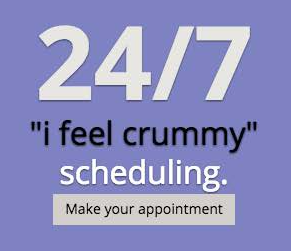 (Advocate Health Care, via Medicom Health)
(Advocate Health Care, via Medicom Health)
Many of the best practices for headline writing apply to CTAs as well. Your copy should be extremely minimalistic, focusing on:
- Clear descriptors of the offer (i.e. “e-book,” “free trial”)
- Powerful words that drive home the benefit of clicking (“increase,” “optimize”)
- Action verbs like “download” and “start,” perhaps followed by “now” or “today”
- JUST OK: "Go"
- MUCH BETTER: "Take the Virtual Tour"
- JUST OK: "Give Our Leading EMS Software a Try -- It's Totally Free for the Next 60 Days"
- MUCH BETTER: "Download a Free, 60-Day Trial"
SEO Writing Tips -- From Professional Content Writers
You’ve heard us reference, and maybe even politely threaten you with, the impact of SEO on website performance. SaaS and medical SEO best practices and keyword research are the two secret ingredients to great copywriting.
While it’s top priority to write blog posts and website pages that help human beings, we also must please the almighty search engines. Producing SEO-friendly content is the only way for your content to rank anywhere near the top of Google search results (or Bing or Yahoo!).
You or someone in your company may find themselves in this role, even if they’re not a professional marketing copywriter or an SEO expert. SEO training isn't necessarily a requirement for online professional content writers, but it sure helps.
Is your team in this boat? Check out these tips:
1. Research Keywords
A great keyword will balance these three qualities:
- Low competition/ranking difficulty
- Moderate search volume
- Highly relevant to your company's products/services AND your customers' interests
We advise choosing long-tail keywords to keep your writing focused and concise. Using the right ones will help you climb search results and reach your target audience.
But what are the right keywords for your content? That’s where research comes into play. By using a keyword tool such as SEMRush or Ahrefs, you can pinpoint the words or phrases you should chase. Most keyword tools have a stripped-down, free version for those strapped for cash.
While you’re researching your keywords, keep these things in mind:
- Keyword volume indicates the number of monthly searches it gets. Using a keyword with no search volume is a waste of time, but keywords with 1,000s of searches per month should make you suspicious of how well you’re honing in on your ideal audience.
- Keyword difficulty indicates how tough it will be to rank for that keyword. Avoid using keywords with a high difficulty (<70 out of 100).
- Search intent is the way in which users look up information, and their reason for doing it. So for a circuit board manufacturer that sells aftermarket services, it might sound swell to rank for “electronics repair.” But most people searching that term are little, old ladies who accidentally downloaded a virus. To reach the correct audience, that manufacturer should try ranking for “electronics remanufacturing” or “PCB repair services.”
2. Use Your Keywords
Your copy should be easily identifiable by Google while also making the EMS tech, nurse or whoever’s reading feel like they’ve solved a problem.
Once you’ve selected a primary keyword, use it in moderation, making sure it ends up in these places at the minimum:
- The title
- At least one H2 subheading (preferably the first one on the page)
- The URL
- The meta description
- The content itself
- Alt text for images
Using your keywords too much, and search engines may penalize you. Limit keyword usage to once every 100-150 words for each keyword. Don't force them into a sentence just for the sake of it.
In addition to the primary keyword, you should also deploy several secondary keywords -- the more, the merrier.
3. Audience Comes First
You aren't the person you need to appeal to in your writing. You're trying to appeal to prospects and potential customers, and that means talking about them and their problems. Don't try to sell anything just yet; that’ll scare readers away.
When you stop talking about your company, potential customers will actually become more interested in doing business with you.
What does this have to do with SEO? Everything, actually. Writing genuinely helpful, customer-centric content means your customers are more likely to:
- Spend more time on the page
- Click your CTA or visit other pages on your site
- Share the article with others
Guess what? All three of those are metrics in Google’s ranking algorithm. So be a nice person and simply … help.
To get a better idea of whether your SEO and copywriting strategies are optimized for each other, get a free assessment below:
4. Make It Obvious
Dancing around the main point is great for reaching minimum length requirements for college essays. It's not so great when you’re writing for the busy healthcare exec looking for a quick answer.
The average person's online attention span is approximately 8 seconds. (Yep, less than a goldfish). If your reader doesn’t find what they're looking for quickly, they're gone.
Internet readers want scannable content. They want to know ASAP if your webpage has the information they need. If it does, they'll hang out longer and read it more closely. If not, you’re better off marketing to goldfish.
5. Find the Best Page Length for SEO
While every tip to this point has told you, “Keep it concise,” concise doesn’t always = short.
The length of your page is a key SEO ranking factor. Google prefers longer content due to its tendency to draw more likes and mentions in social media. Also, visitors naturally spend more time on longer pages, and “time on page” is another major Google ranking factor. And finally, the more you write, the more keywords you’re likely to include organically.
But we know what you really want: a magic number for minimum word count.
Sadly, that number doesn’t truly exist -- click on 10 different articles about webpage length, and we guarantee you’ll get at least five different answers. We’ve seen the minimum threshold of 300 words floated around a lot -- and this is indeed a nice starting point for your homepage, About Us page, and Service pages.
Landing pages don’t always need 300 words, but adding some contextual information about the topic below the submission form (you never want to bury it) can improve SEO rankings.
As for the best blog post length, the past year or so has seen many experts call for a minimum of 1,500-2,000 words. Yikes.
While there’s no perfect answer for any page type, we’ll say this -- with niche B2B, SaaS, or healthcare technology blog topics, 2,000 words may be unrealistic. There’s only so much you can say about hyper-niche topics. Copy should never be redundant or fluffed out for the sake of length.
Every sentence should entertain or help, either directly (telling them how something works) or indirectly (using an analogy to make your point clear).
6. Write, THEN Optimize
Two key parts of ranking in search engines are writing quality and audience relevance. Those two factors, at least initially, have nothing to do with data and research -- they’re just springboards for improved conversion and time-on-page rates.
So before you SEO-ify your copy, think about what information matters to your audience, and what will help them solve a problem they're facing. Once you've done that, go back through your SEO checklist:
- A short meta description that describes your post
- In-text links to helpful content -- both inbound (your company’s resources) and outbound (third-party resources)
- A relevant CTA to a valuable offer, increasing conversions and lowering bounce rate
- Body copy that compels the reader to take action
- Copy that focuses on the customer, not your brand
Email Marketing Writing Tips 📧
B2B email marketing is alive and well, despite what you may have heard or read to the contrary.
Too much of medical email marketing relies on one-off blasts asking for business. Or, worst of all, the company purchases contact lists. (Never do this.)
Because most B2B purchases are expensive and complex, there can be long sales cycles and multiple decision-makers involved.
That’s why you should use healthcare email marketing to:
- Promote blog posts to increase traffic
- Follow up with new leads who have downloaded an offer to keep your name top-of-mind
- Test what topics do and don’t interest your customers
- Create personalized, “human” sales touchpoints that build relationships
- Re-engage old contacts when you’ve got something big to announce (i.e. a new product or facility)
Subject Line
Let’s start at the top, because not enough writers put thought into their marketing email subject lines.
In most cases, the primary goal of your subject line is to tell people what they're getting by opening. Did you just say “Well, duh” out loud? Go to your inbox (or your spam folder) and see how many email subject lines are vague or mysterious.
Make the benefit of opening your email very clear, or at least use a clever (but relevant) hook to make the recipient curious. Create a sense of urgency or importance. Leveraging FOMO (fear of missing out) never hurts.
As usual, keep things brief. A good average length for subject lines is 55 characters. It's better to be under that number than over it.
Elements to use:
- Powerful adjectives and verbs ("invited," "collapse," "ridiculous")
- Questions
- Numbers (they catch the eye) and shocking stats
- Personalization tokens (For example, studies show open rates rise when the recipient’s name is in the subject.)
- Emojis (when appropriate)
Bad Examples of Subject Lines
- "Check this blog out!! Did you see this?!!!"
- "Quick question"
- "ACME INDUSTRIES NOVEMBER NEWSLETTER"
- "Request a quote for our high-quality precision medical device machining"
Good Examples of Subject Lines
- "Are you the only commercial printer still using unsustainable ink?"
- "7 ways to keep your box build from exploding"
- "VIDEO: Proof you should use 80 KSI steel for electronic enclosures”
- "Here's your e-book download"
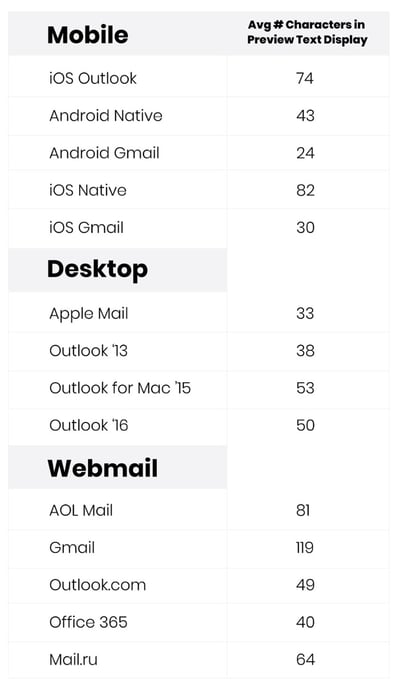 Preview Text
Preview Text
Preview text should contain a quick "hook" that tells readers what they're getting by clicking and/or why it's important. Basically, whichever of those two things is accomplished in the subject line, the preview text should handle the other. The preview text and subject line shouldn’t be a repeat of one another.
Optimal preview text length is 40-140 characters, depending on email client. Since there's such a big variation, stick to the shorter side so your text isn't cut off in the reader’s inbox. Conversely, you should also use the preview text to stick in details that would make the subject line too unwieldy.
Bad Examples of Preview Text
- (If you already used Subject Line Good Example #1 above:) "You shouldn't be the only commercial printer not using sustainable ink. Here's why:"
- "Sustainable healthcare products are the future of the printing industry. This is one of just many trends you should be keeping an eye on for 2021 and beyond. Keep reading below if you want to stay ahead of the curve -- and your competition.
Good Examples of Preview Text
- "Follow these tips straight from the experts to make your EMR software integration go more smoothly.”
- "This e-book covered a lot of ground. Any questions you have on improving your medical device design’s efficiency?"
General Email Copywriting Best Practices
Now, on to the main course. The body of the email is where you create value and call for the reader to take action.
We broke this section down for you into three parts:
- Copywriting for standard sales/marketing emails
- Copywriting for content offers/teasers
- Copywriting for conversion follow-ups (and breakup emails 💔)
Standard Sales/Marketing Emails
Remember how short attention spans are in today’s digital world? You can cut that time in 1/2 for email marketing.
- Keep your email copy lean, especially in introductory sections. For something like a blog roundup newsletter, you probably don't even need an intro -- just jump right into the preview blurbs for the blog posts.
- Speak "with" the reader and not "to" the reader -- make them feel like they’re part of the conversation. Speak in the second person where possible.
- Talk about benefits, not features. Even if your email promotes your client as a solution, you still need to present your case in an inbound-friendly way. What is the end benefit of a certain feature of the product/service -- one that the customer would actually care about?
B2B Email Marketing Example -- BAD
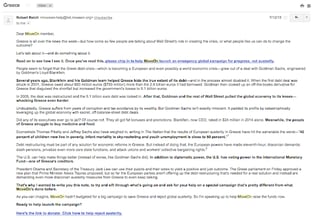
Why is this email bad?
- A subject line of just “Greece” isn’t very clickable, even if Greece was a hot topic at the time of sending.
- It takes about 12 paragraphs to get to the point.
- The CTA is merely two small text links adrift in a sea of copy.
B2B Email Marketing Example -- GOOD
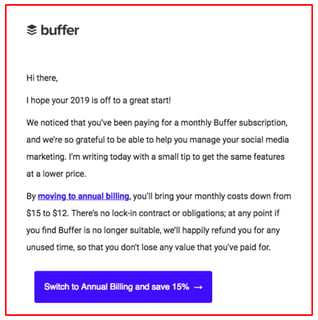
Why did this email succeed?
- It wastes no time explaining why the reader should care.
- It offers value ASAP.
- The CTA is big and clearly explains the offer’s value.
Copywriting for Content Teasers
"One of the worst mistakes email copywriters make is trying to shove the entire story into the email message." -- HubSpot
A blurb previewing a blog post (say, for a monthly newsletter) should rarely exceed two sentences spread over 1-2 paragraphs.
A great practice is to pull copy from the blog post's intro and trim it from there. The blog post's copy, if done well, should already have the "what" and the "why" you need to hook your email readers.
If you’re copywriting for promotion of a download offer -- i.e. an e-book, a consultation, or even a brochure download -- keep the blurb to 1-2 sentences. As always, leave the sales-y speech at home as much as possible.
- BAD: "Acme Cardiovascular Technologies is the world's leading stent provider. To see our product, click below:”
- GOOD: "Did you know new innovations in stents reduce rejection rates and increase blood flow? Click below for a free demonstration:”
Copywriting for Conversion Follow-Ups
Whenever someone fills out a form on your site (i.e. to download an e-book) and becomes a lead, you should enter them into a workflow -- a series of follow-up emails. (A pat on the back if you’ve used automation to save time here.)
When setting up a series of follow-up emails, remain educational and helpful. We know you’re excited about your new lead -- and itching to send your sales pitch -- but hold your horses.
Here’s an example workflow:
- In Follow-Up Email #1: Simply offer their download link and tell them you’re happy to answer questions. Subject line should be short and obvious (i.e. “Here’s your download link”)
- Mid-Stage Follow-Ups: Reiterate your ability to answer questions; ask what they thought of the e-book; offer additional blog posts or an e-book. Subject line should offer value (i.e. “More resources for improving your circuit board design”)
- Breakup Email: Make it clear this is your last email. Then offer a final premium offer, free consultation, etc. Subject line should say goodbye and offer value once more (i.e. “Final check-in and additional resource”)
Example of Copywriting for Follow-Up Email #1 -- GOOD
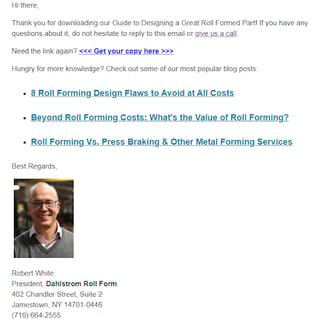
Why did this email succeed?
- It puts the customer’s education first.
- It’s short and gets to the value quickly.
- It feels personal -- it’s from the president and even has his picture.
Example of Copywriting for Follow-Up Email #2 -- BAD
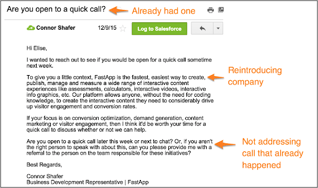
(Courtesy Yesware)
Why did this email fail?
- It immediately requests a call -- it’s way too early for that!
- There’s a huge chunk of self-promotional BS
Example of Breakup Email Copywriting -- GOOD
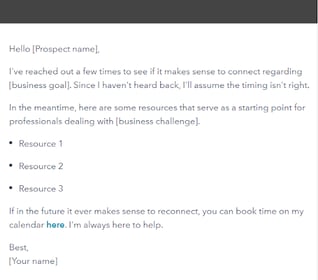
Why did this email succeed?
- It respects the reader’s time.
- It still offers value.
- It contains an easy-to-use “book a meeting” feature
As much as possible, a marketing or sales email (especially a sales email) should feel like a 1-on-1 conversation with an acquaintance.
Social Media Marketing Writing Tips #️⃣
SaaS and medical device social media marketing isn’t likely to be your biggest driver of traffic and sales, but it’s still worth your time.
Why does high-quality social media content writing matter? It unlocks your ability to:
- Educate prospects on pain points
- Gauge what topics are important to prospects
- Drive engagement and connections
- Spread awareness of your brand
- Humanize your company
- Get noticed and shared by third-party publications
- Increase website traffic!
Yes, mass production of social posts can be tedious. But don’t take the path of least resistance, slap the article title and link in the text window, and hit “Publish.”
B2B Social Media Copywriting Tips for All Platforms
Let’s start by circling back to our scolding above.
Simply copy-pasting the title and link is a missed opportunity to “hook” the reader. It also looks lazy and spammy to readers when all they see is “5 Benefits of Billing Software for Your Medical Practice” with a link.
Instead, pull the most interesting fact, stat, or quote from your blog post (or whatever you're sharing) and highlight it as your "hook." If you’re citing a third party, tag them in the post to increase your reach.
Tweak wording (and, when possible, images) from post to post. This way, people who see you across multiple platforms will have extra incentive to click -- your Facebook teaser might not interest them, but maybe your Instagram one will.
Tone should be at least somewhat consistent with your blog writing, email writing, and video creation (although social media posts can be a little more relaxed).
A final plea: For the love of the Kardashians, don’t riff off serious news or trends with a tongue-in-cheek tweet or post. Puns and lead-ins based off a deadly earthquake or racial injustice protests are … not wise.
Now, on to some platform-specific tips:
LinkedIn Business Posting Tips
LinkedIn is almost always the heart of social media marketing B2B and SaaS strategies.
Because this is a “work before play” platform, keep your posts on-topic. Present them as “news you can use” -- how-tos, diagrams, and so on.
And, of course, keep your tone a little more buttoned-up than you would on, say, Facebook. Save your “LOL”s and emojis for another time.
The Nuts and Bolts
- Hashtags: 3-5 at the end of the post
- Emojis: No
- Length: Longer (but still be concise and focused)
Example of BAD Social Media Marketing Copy -- LinkedIn
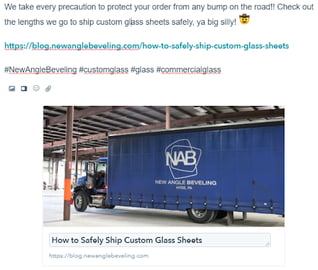
Why would this imaginary post fail?
- The blog post it’s promoting is supposed to be educational, but the social post looks like a sales pitch.
- The tone doesn’t match LinkedIn’s -- or this company’s -- more serious demeanor.
Example of GOOD Social Media Marketing Copy -- LinkedIn
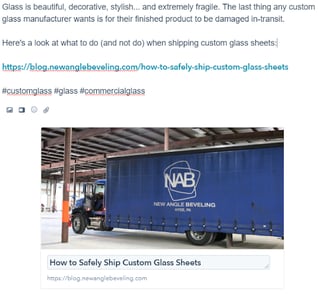
Why did this post succeed?
- It addresses a customer pain point.
- It suggests an action for fixing that pain point.
Facebook Business Posting Tips
Depending on your business, much of your Facebook following may be community and family members. Since they’re not experts on your target industries, you should speak to them like they’ve never seen your product/service before.
Find the little nugget of info or hook that will convince a casual observer to open an article on a “boring” topic.
The Nuts and Bolts
- Hashtags: In 2020, Facebook finally started encouraging hashtag use. Whether they increase reach or not is still a mystery
- Emojis: Yes
- Length: Medium
Example of BAD Social Media Marketing Copy -- Facebook
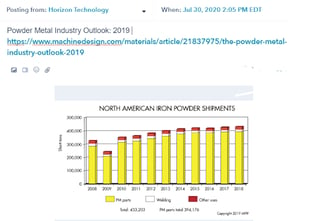
Why did this imaginary post fail?
- It’s clear nobody put any effort into the post -- it’s just the title and link
- It doesn’t tell readers why they should care.
- The chart isn’t exactly a thriller.
Example of GOOD Social Media Marketing Copy -- Facebook
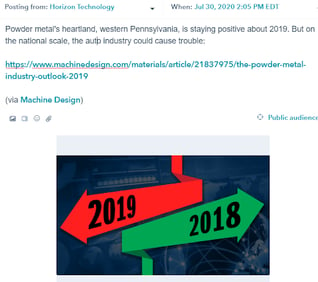
Why did this post succeed?
- It’s tailored to the company’s regional presence, which is where most of its Facebook followers are located.
- It has a “hook” -- it mentions concerns that could affect the reader.
Twitter Business Posting Tips
For B2B social media strategies, think of Twitter as a mix of Facebook and LinkedIn. You don’t need to be super buttoned-up, but you should stay focused on education and professional/industry news.
The Nuts and Bolts
- Hashtags: ~2 per post, which can be sprinkled within the body of the post (Just don’t make it a chore to read)
- Emojis: Yes
- Length: Short (Remember the 280-character limit)
Example of BAD Social Media Marketing Copy -- Twitter
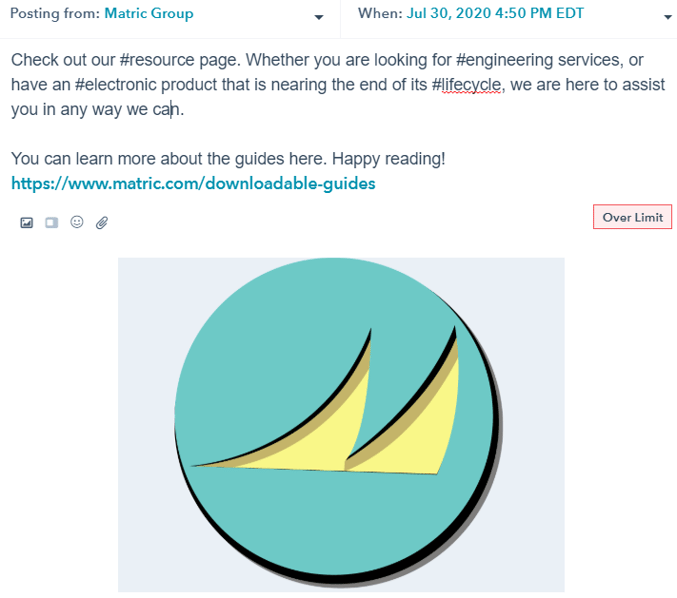
Why did this post fail?
- The hashtags are excessive and intrusive.
- It’s 2x longer than necessary.
- It looks like an advertisement, not as a valuable offer.
Example of GOOD Social Media Marketing Copy -- Twitter
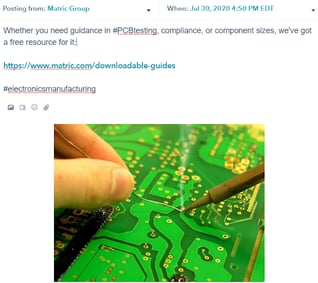
Why did this post succeed?
- It uses hashtags wisely.
- It speaks to the customer’s needs.
- It gets to the point quickly.
YouTube Description Best Practices
Why did we sneak YouTube in here?
YouTube is a combination of a social-sharing platform and the world’s second-largest search engine (Google being #1).
If your product/service has video demonstrations or other educational videos, you need to supplement those efforts with copywriting.
“But they’re there to watch a video, not read something!” you protest. That’s 100% true, but video SEO is just as important as blogging or website SEO. And that means you need a written description of your video.
There are plenty of free transcription services out there that can handle this, but the result is almost always grammatically awful and devoid of keywords.
Here’s what you need to do before you share your company’s creation with the masses on YouTube:
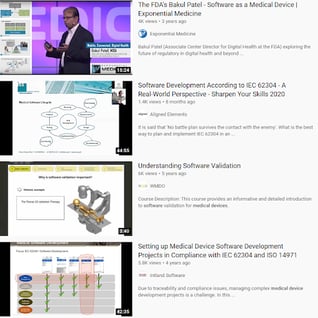 YouTube Description Length
YouTube Description Length
Your description should be at least 150 words. Make it a conversational overview of your video. Tell the viewer what they’ll learn and something compelling that sets your video apart.
This tells YouTube more about your content. The more YouTube knows, the more likely it is to rank your video highly in search results.
Each of your videos’ descriptions must be unique to get the best results -- no duplications!
The First 2-3 Sentences
Your description’s first 2-3 sentences are the most important for two reasons:
- They appear with your video in search results and “suggested videos” lists
- They appear directly below your video while it plays
Much like with blogging, you should have a primary keyword that describes your video. Work it into the description early (plus the video title).
Create Functional Descriptions
Use the “show more” section to add info about your YouTube channel and a link to your company’s website, related blog post, or other social media pages.
Repeat the target keyword 1-2 more times if you can without sounding spammy. This will reinforce to YouTube what your video is about.
Include labeled timestamps for longer videos so viewers can jump straight to the part they care about most. And if you’re creating a video series, link to its playlist!
YouTube Hashtags
Include a hashtag in your description if your video relates to a trending topic or upcoming event, like a medical trade show you’re attending.
Make them specific enough to the client's niche, without being too specific. (This goes for other social channels, too.)
- Bad: #software
- Good: #billingsoftware
- Best: #medicalbillingsoftware
- Dial it down, champ: #anesthesiamedicalbillingsoftware
If Instagram’s demographic doesn’t fit with your SaaS or medical tech persona, skip Instagram and focus on other channels. However, if you have a younger audience, Instagram is a great place to post “behind the scenes” looks, contests, and so on.
Use Instagram to:
- Promote engagement (teasing a link in your bio or asking a question)
- Stay lighthearted
- Frontload the important info -- people aren’t on Instagram to read words!
The Nuts and Bolts
- Hashtags: Use several at the end of the post
- Emojis: Yes
- Length: On the shorter end
Example of BAD Social Media Marketing Copy -- Instagram
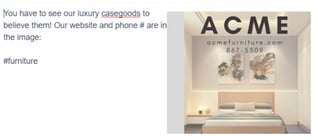
Why did this post fail?
- It’s too sales-y
- The photo is barely a photo -- it’s plastered with the company’s contact info.
- Its hashtag is too broad
Example of GOOD Social Media Marketing Copy -- Instagram
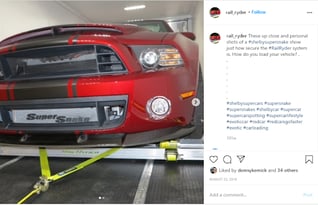
Why did this post succeed?
- It shows the product in action.
- It asks a question to promote engagement.
- It has a good mix of practical and whimsical hashtags.
In-House Copywriting vs. Medical Technology Marketing Agencies
If you’ve made it this far, congratulations. You’ve found the ingredients to whip up a med tech or SaaS content strategy that matters -- and that gets results.
What now? You’ve got to execute. Whether you insource or outsource, your medical B2B marketing campaign won’t survive unless it accurately measures your persona’s heartbeat, and delivers consistent, high-quality content.
To learn more about how to bake each aspect of content marketing into a cohesive, successful campaign, click the button on the left. However, if you’ve got a “too few cooks” situation and aren’t sure your small team’s effort is paying off, book an assessment via the button on the right.



